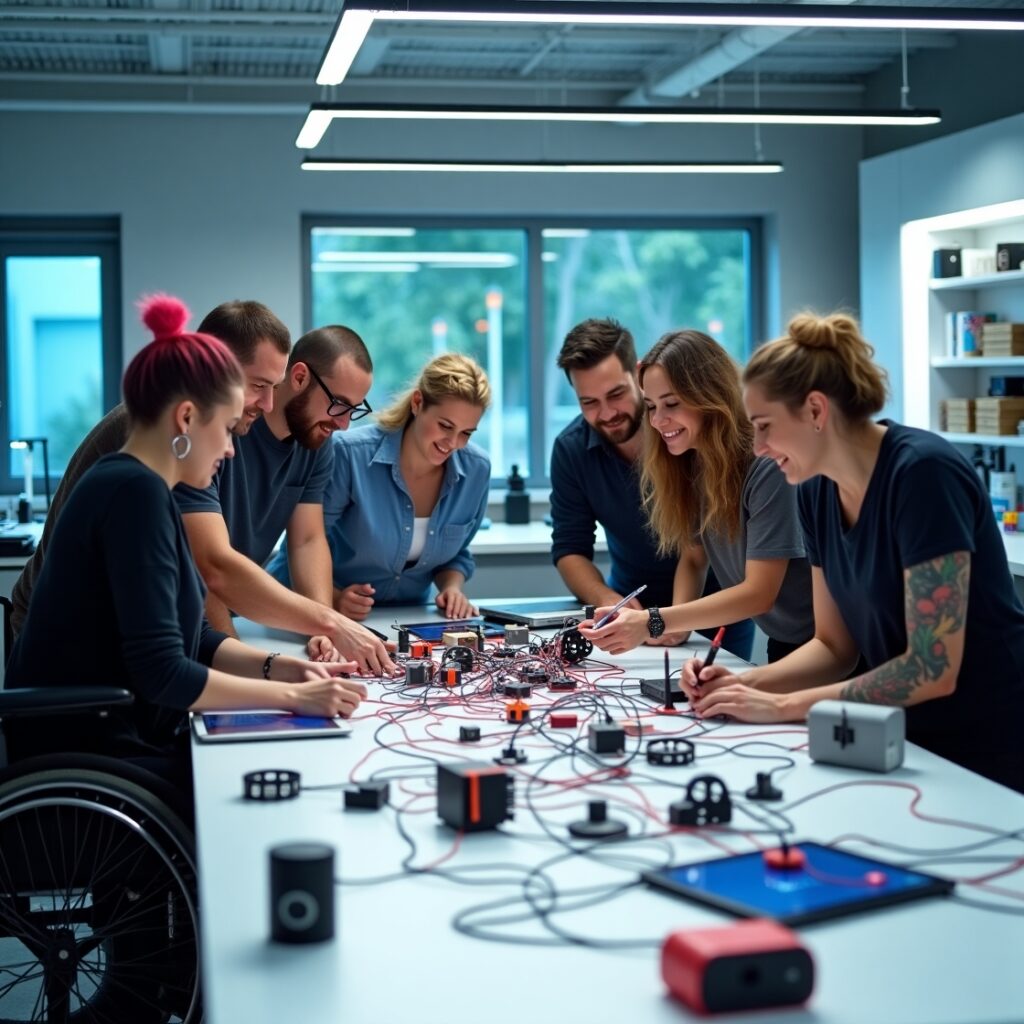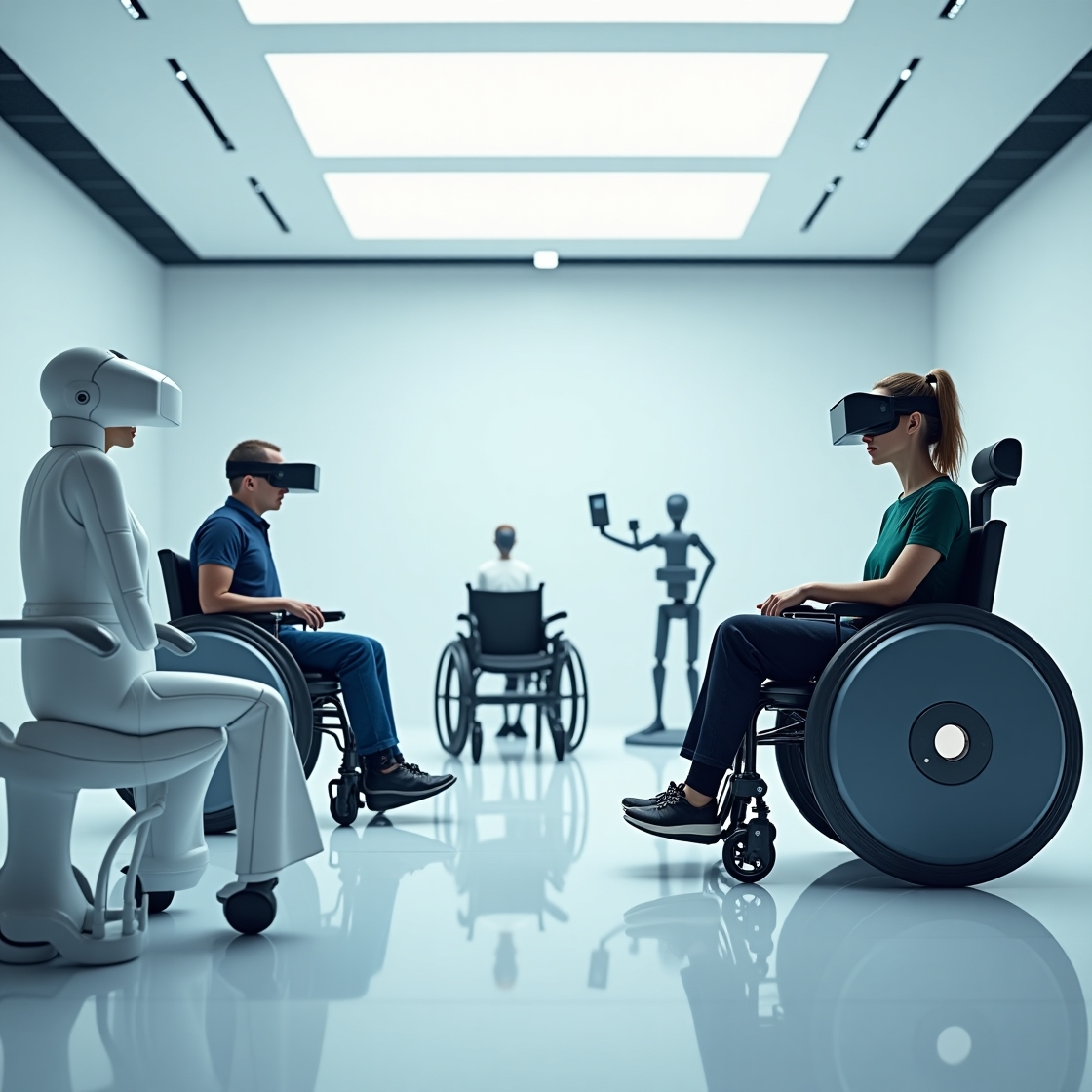High tech assistive technology has transformed from basic mobility aids to sophisticated systems that provide unprecedented independence. By 2025, these innovations will bridge critical gaps for the 1.3 billion people worldwide living with disabilities,creating more inclusive environments in all aspects of daily life.”
Specifically, the integration of AI prosthetics and wearable assistive devices has revolutionized accessibility options. Disability innovation continues to accelerate, with assistive technology for people with disabilities and responsive. Furthermore, assistive wearables have evolved beyond simple function to offer personalized experiences that adapt to individual needs and preferences. As a result, users gain not only practical assistance but also greater autonomy and social inclusion.
This article explores how 2025’s cutting-edge accessibility solutions are breaking barriers through integrated AI assistants, advanced wearable devices, personalized adaptive systems, and community-driven innovation approaches that prioritize inclusive design principles.
High Tech Assistive Technology From Standalone Tools to Integrated AI Assistants
The year 2025 marks a decisive evolution in accessibility tech—moving away from isolated, single-function applications toward comprehensive AI assistants that serve as digital companions for users with disabilities. These sophisticated systems deliver seamless support through natural conversation rather than complex menu navigation.
Voice-First Interfaces in High Tech Assistive Technology
Voice-first technology has matured considerably, transitioning from a novelty to an essential interaction method. In 2025, voice interfaces prioritize speech as the primary input channel while complementing audio output with tightly integrated visual displays when needed. This approach proves especially valuable for users with visual or physical impairments, as well as those with lower literacy levels 1.
Unlike traditional screen-first systems that merely add voice commands as a secondary feature, today’s voice-first assistants:
- Process natural language queries without requiring specific command phrases
- These assistants provide sequential numbering for easier audio navigation
- Display immersive, interactive content accessible through voice commands 2
Real-Time Query Resolution with ally and Be My AI
The ally assistant exemplifies the new generation of AI companions, offering extraordinary speed and contextual understanding. Rather than forcing users to navigate complex menus, ally enables direct questions with precise answers delivered in under two seconds 3.
Meanwhile, Be My AI has been integrated into Microsoft’s Disability Answer Desk with remarkable results. The system achieves a 90% successful resolution rate without human intervention and solves customer issues in approximately 4 minutes—three times faster than traditional support 4. Additionally, it offers text-based responses accessible through refreshable Braille displays, making customer service accessible to Deaf-blind users for the first time 4.
Task Automation for Daily Routines
Beyond answering questions, modern AI assistants excel at automating routine tasks. Users can set up morning routines including alarms, weather reports, traffic updates, meeting reminders, and news briefings 5. The systems can control smart home devices like lights and thermostats through voice commands, especially beneficial for those with mobility limitations 5.
Even users with non-standard speech patterns can access these conveniences through specialized apps like Voiceitt, which learns individual speech patterns to facilitate voice command access 5. Additionally, AI-powered assistants can analyze patterns to predict user intentions, benefiting people with motor disabilities or cognitive impairments 6.
Essentially, these integrated AI systems represent a fundamental shift in assistive technology—from tools that perform discrete functions to intelligent companions that understand context, learn from interactions, and proactively support independence across all aspects of daily life.
Wearable Accessibility Devices and Smart Glasses

Wearable devices represent the tangible embodiment of accessibility technology, with smart glasses leading this innovation wave. These discrete, hands-free solutions transform visual information into audible cues, giving unprecedented independence to users with visual impairments.
Scene Recognition in Envision Glasses: A Milestone in Assistive Technology 2025
Envision Glasses exemplify how AI-powered eyewear serves as an extension of human perception. These lightweight smart glasses feature a built-in camera and speakers that convert visual information into spoken descriptions. The “Describe Scene” function delivers immediate analysis of surroundings, helping users understand their environment without assistance 7. Beyond basic descriptions, users can interact with the AI through follow-up questions like “What items are on the table?” or “What type of plant is that?” 8. The glasses excel at reading text in over 60 languages, recognizing faces, detecting light levels, and identifying colors 9.
Multilingual Support in Smart Wearables
Language barriers disappear with today’s wearable accessibility devices. Multilingual speech recognition enables interaction regardless of the user’s native tongue 10. For instance, researchers developed a color-detection wearable that announces colors in both Bengali and English through connected headphones 11. Envision Glasses similarly process text in dozens of languages, making written information accessible globally 7. This capability proves particularly valuable for travelers, expatriates, and non-native speakers who need to switch between languages seamlessly 10.
Hands-Free Navigation for Visually Impaired Users
Navigational independence comes through innovations like ALVU (Array of Lidars and Vibrotactile Units), which uses time-of-flight sensors to detect obstacles. The system consists of a sensor belt worn around the waist and a haptic strap that communicates distances through vibration patterns 12. Shorter distances trigger increased pulse rates with stronger vibrations, allowing users to navigate safely without using their hands 12. In testing with 12 blind participants across 162 trials, users successfully walked through hallways, avoided obstacles, and detected staircases 12. Similarly, smart glasses with spatial awareness create digital maps of surroundings, enabling confident movement through unfamiliar areas 13.
Personalized Accessibility Through Adaptive AI
Adaptability stands at the core of 2025’s most effective assistive technologies. Beyond simply functioning as tools, these systems now learn from users and modify their behavior accordingly, creating truly personalized accessibility experiences.
Customizable Assistant Personalities
Modern high tech assistive technology now enables users to tailor AI personalities to match their unique preferences. Envision’s AI assistant ‘ally’ exemplifies this advancement, allowing customization of conversational styles, from professional tones for workplace settings to more casual approaches for personal use This personalization transforms accessibility tools from mechanical utilities into engaging companions.
Speech recognition systems now adapt to individual speech patterns, including those with non-standard speech, stuttering, or speech affected by motor impairments 15. Moreover, these AI-powered systems can generate customized educational materials, creating simplified versions of complex texts for users with cognitive disabilities 16.
Context-Aware Interaction Models
Context-awareness represents a significant advancement in disability innovation. These systems autonomously acquire environmental information, perform reasoning, and adapt behaviors accordingly 17. Through semantic knowledge frameworks and specialized rule languages, context-aware systems can model a user’s surroundings and intentions without constant manual configuration 17.
For people with cognitive impairments, these systems autonomously plan activities and provide timely notifications 17. Consequently, tech for the disabled has evolved beyond reactive functions—becoming proactive by anticipating needs and customizing support 18. This capability proves particularly valuable for individuals with cognitive, speech, or mobility disabilities who benefit from interfaces that adapt to their specific requirements 15.
User Feedback Loops for Continuous Learning
Assistive wearables now incorporate sophisticated feedback mechanisms that constantly refine their performance. Through backpropagation algorithms, these systems identify inconsistencies and feed corrected information back into their models as input 19. This creates a continuous improvement cycle where the AI becomes increasingly accurate over time.
Human experts remain crucial in this process, guiding AI systems when needed 19. As customer needs change, these feedback loops enable AI models to adjust and grow even more precise 19. For instance, AI can identify potential inaccuracies or confusions and have human reviewers verify proper routing of new incoming messages 19. Such collaborative approaches ensure assistive technology truly serves individual needs rather than forcing users to adapt to rigid systems.
Community-Driven Innovation and Inclusive Design

User involvement lies at the heart of today’s most successful high tech assistive technology. Indeed, the shift from designer-centric to user-centered development has fundamentally improved how these technologies serve real-world needs.
Beta Testing Programs and User Feedback
The evaluation of assistive technologies through user feedback has become a critical component driving refinement and customization. For example, the HET wearable assistive technology program was developed specifically with user feedback to ensure accuracy and ease of use, empowering users to navigate social interactions confidently in both personal and professional settings 20. This approach helps surface accessible user experience issues that automated or manual technical inspections might miss before product launch 3.
AT User Flow Testing provides valuable insights from experienced assistive technology users on critical user journeys, offering an affordable way to identify accessibility challenges early 3. Through this process, engineers with disabilities test each flow, recording their experiences and recommending necessary changes. These testers carefully note where they used approaches that other assistive technology users might not know about, considering potential differences in how barriers impact different people 3.
Collaborative Development with Disability Advocates
Successful disability innovation happens primarily through partnerships with advocacy organizations and direct involvement of people with disabilities. The National Association of Councils on Developmental Disabilities (NACDD) works with State Councils on Developmental Disabilities to empower people with developmental disabilities, their families, and allies to build welcoming communities 21.
Microsoft’s approach demonstrates the value of direct collaboration – their grant program supports researchers, startups, nonprofits, and assistive technology companies developing innovative technologies that empower people with disabilities 22. Notably, they prioritize funding ideas developed by or with people with disabilities.
The benefits of this collaborative approach include:
- Enhanced stakeholder engagement leading to more informed, better-tailored solutions
- Increased innovation through diverse perspectives that might not emerge in expert-led contexts
- Greater education and awareness about accessibility needs throughout development teams
Since these collaborations involve multiple stakeholders, they foster trust, satisfaction, and long-term partnerships that continue improving assistive wearables over time 23.
Conclusion
Assistive technology stands at a transformative threshold as we approach 2025. The evolution from basic tools to sophisticated AI-powered systems has essentially redefined what accessibility means for the 1.3 billion people worldwide living with disabilities. Throughout this journey, four critical developments have emerged as game-changers.
Integrated AI assistants now function as comprehensive digital companions rather than isolated applications. These systems understand natural language, resolve queries instantly, and automate daily tasks without requiring users to navigate complex interfaces.
Smart glasses and wearable devices simultaneously provide unprecedented independence through scene recognition, multilingual support, and hands-free navigation. Users gain real-time environmental information through discrete, socially acceptable devices that translate visual data into audio feedback.
Adaptive AI technology additionally creates truly personalized experiences by learning individual preferences, adapting to unique speech patterns, and anticipating needs through contextual awareness. This personalization transforms mechanical tools into engaging companions that grow more effective over time.
Perhaps most significantly, the shift toward community-driven innovation ensures these technologies actually address real-world challenges. Direct collaboration with disability advocates and comprehensive user testing programs have fundamentally improved how assistive technology serves genuine needs.
Together, these advancements promise a future where technology not only supports people with disabilities but actively empowers individuals to participate fully in society. The barriers that once limited independence are falling as assistive technology becomes smarter, more intuitive, and genuinely responsive to each person’s unique requirements. This represents more than technological progress—it marks a profound shift toward a world designed for everyone.


[…] Athletic Success How Automotive Service Technology is Transforming Vehicle Repairs in 2025 High Tech Assistive Technology in 2025 9 Jul 2025, […]